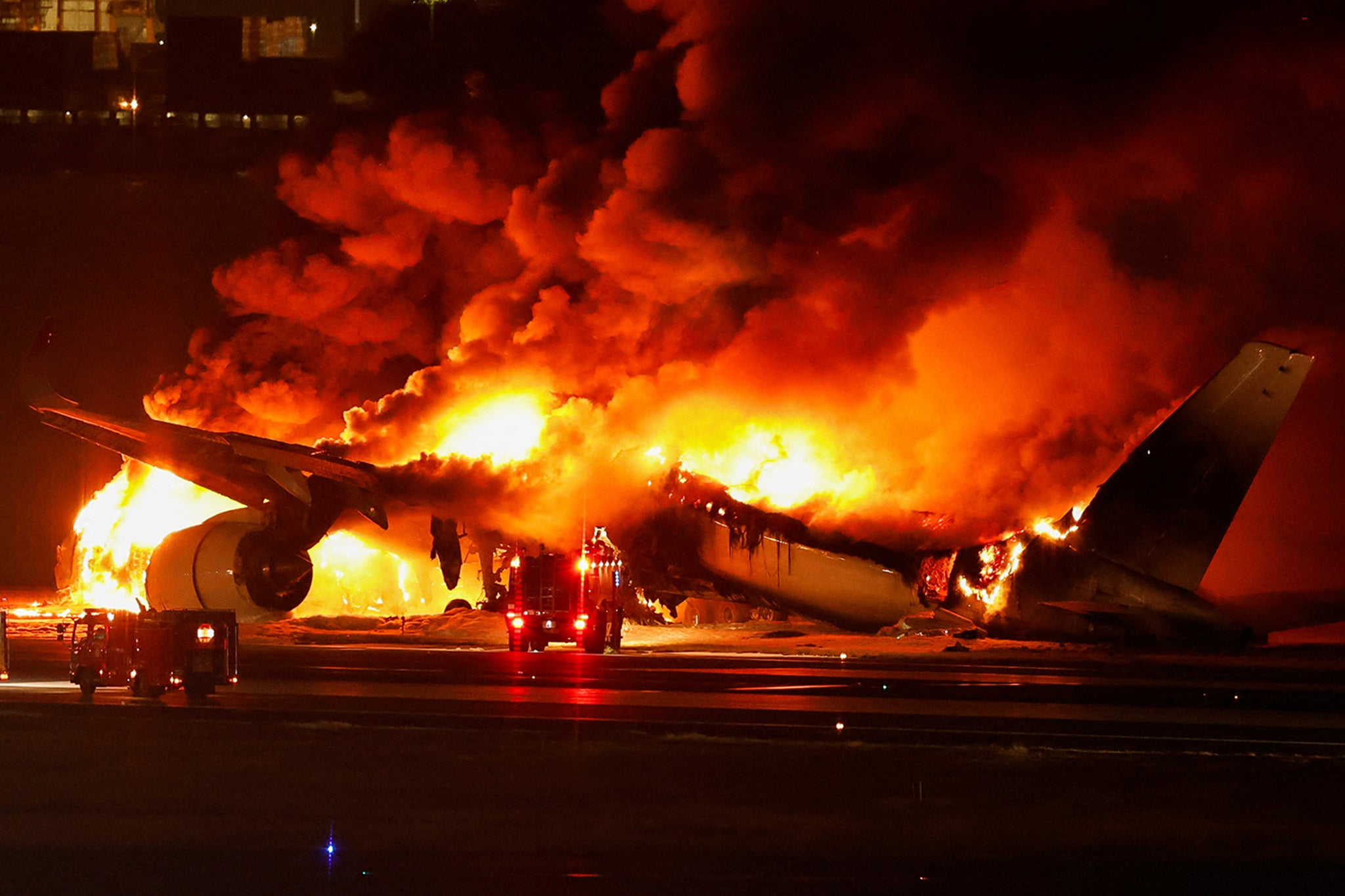Japan Airlines passengers and crew praised for ‘textbook’ evacuation of burning plane
Those involved describe scenes of ‘hell’ after plane caught fire on landing. Yet experts say crew and passengers conducted a textbook emergency evacuation, meaning none of the 379 on board were harmed
Passengers on board the Japanese Airlines (JAL) flight which caught fire on landing in Tokyo on Tuesday have recalled the scenes of chaos that unfolded, as well as the successful evacuation that saved the lives of all 379 people on board.
While the airline crew has been widely praised for the “textbook” evacuation of passengers, those on board flight JAL-516 compared the situation inside the aircraft to "hell".
The Japan Airlines-operated Airbus-A350 and a Japan Coast Guard aircraft collided on the runway at Tokyo's Haneda Airport on Tuesday evening and both burst into flames, killing five out of six people aboard the military plane.
The Coast Guard team had been preparing for liftoff to deliver aid to those hit by the powerful earthquake that killed 62 people in Ishinaka on New Year’s Day.

Television footage showed an orange fireball erupting from the plane as it collided while landing. Passengers were instructed to leave their belongings inside and get away from the aircraft as soon as they hit the ground, moments before a loud explosion was heard.
Soon, the entire aircraft was ablaze.
Yet despite the severity of the fire, all 379 people including 12 crew members got out safely before the Airbus was fully engulfed in flames, transport minister Tetsuo Saito said.
Videos shot by passengers from inside the aircraft showed smoke quickly spreading inside the cabin as crew tried to explain the evacuation process.
Anton Deibe, a 17-year-old passenger from Sweden said "the entire cabin was filled with smoke within a few minutes”.
“We threw ourselves down on the floor. Then the emergency doors were opened and we threw ourselves at them.
"The smoke in the cabin stung like hell. It was a hell. We have no idea where we are going so we just run out into the field. It was chaos," the passenger told Swedish newspaper Aftonbladet.

Aviation analyst Alex Macheras told the BBC that the crew “were able to initiate a textbook evacuation” in just a few minutes after impact. He praised the crew for successfully identifying which emergency exits were away from the fire, which was “isolated to one area” for around 90 seconds, allowing the briefest of windows for everyone to get out.
Safety consultant John Cox told the Associated Press that the cabin crew “did a remarkably great job” getting passengers out of the plane.
“It shows good training,” Mr Cox said. “And if you look at the video, people are not trying to get stuff out of the overheads. They are concentrating on getting out of the airplane.”
Pilot and aviation correspondet Pete Muntean said the incident represented a “massive failure of Japan’s ‘safety first’ culture”, but added that what followed was “a textbook evacuation by Japan Airlines’ crew”.
A woman described the cabin being dark and hot as the fire intensified after landing. "It was getting hot inside the plane, and I thought, to be honest, I wouldn't survive," she told state broadcaster NHK.
A 28-year-old man returning from a trip to Hokkaido bounced off his seat from the impact upon landing. "We made it just in the nick of time. It's a miracle we survived," he told Nikkei Asia.
The crew repeatedly asked the passengers to stay calm and in their seats, while covering their noses and mouths with oxygen masks.

Once the emergency exit was opened, passengers were seen panicking, with some shouting: "Get us out of here". All passengers and crew members eventually slid down the escape chutes to escape the fire.
Another passenger in his 50s said: "I think everyone was able to escape in about five minutes."
Passenger William Manzione shared a photo on social media moments after the evacuation, saying they were all safe and being taken to the terminal.
“We got home safe and sound. Kids and family have been amazing enduring this emotional stress,” he said in a follow-up post.
“So sorry to hear about the Coast Guard crew. Couldn’t figure out that another plane was involved, I’ve just witnessed the amazing work of the JAL crew taking everyone onboard to safey,”
At least four people were taken to a medical facility after the incident, the Japanese Airlines said.
Twelve Australian nationals were on board the passenger plane and managed to escape unhurt, Australian foreign minister Penny Wong confirmed on Tuesday.

Prime minister Anthony Albanese offered condolences adding: "Our hearts go out to our friends in Japan."
JAL managing executive officer Tadayuki Tsutsumi told a news conference late Tuesday that the A350 was making "normal entry and landing" on the runway, without specifying how it collided with the Coast Guard plane.
The airline maintains that the flight had received permission to land from aviation officials.
Coast Guard spokesperson Yoshinori Yanagishima said its Bombardier Dash-8 plane, which is based at Haneda, had been due to head to Niigata to deliver earthquake relief goods.

Shigenori Hiraoka, head of the Transport Ministry Civil Aviation Bureau, said the collision occurred when the JAL plane landed on one of Haneda's four runways where the Coast Guard aircraft was preparing to take off.
Japan's transport authorities on Wednesday said they were investigating the cause of the collison and analysing communication between aviation control officials and the two aircraft. Police have also opened an investigation into possible negligence.
All runways were shut after the incident on Tuesday evening, and JAL announced the cancellation of more than 40 domestic flights to and from Haneda airport on Wednesday.
Join our commenting forum
Join thought-provoking conversations, follow other Independent readers and see their replies
Comments
Bookmark popover
Removed from bookmarks